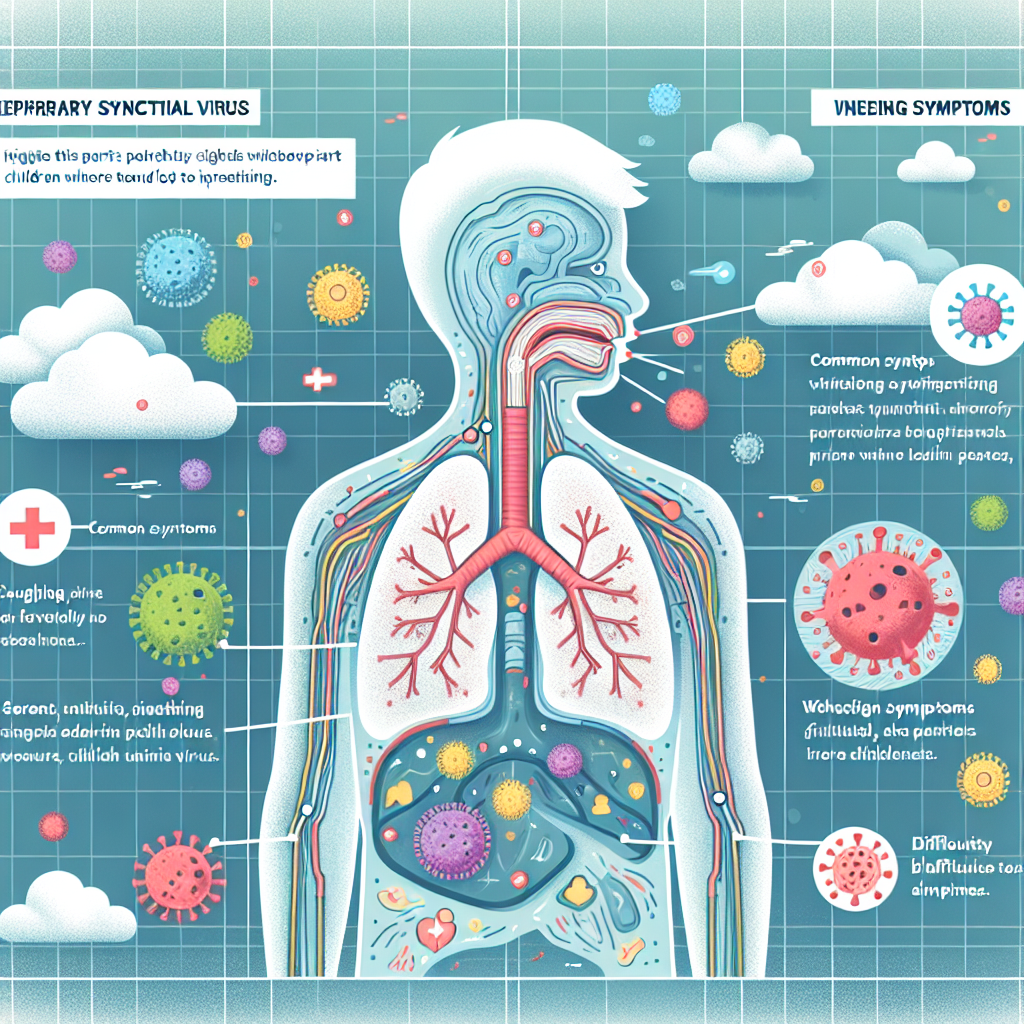In this informative article, you will gain a comprehensive understanding of the symptoms associated with Respiratory Syncytial Virus (RSV) in children. By exploring the various indicators of this prevalent respiratory infection, parents and caregivers will be equipped to recognize potential warning signs in their little ones. From coughing and wheezing to nasal congestion and difficulty breathing, familiarizing yourself with these symptoms will help you identify RSV in kids early on, allowing for prompt medical attention and treatment.

Understanding Respiratory Syncytial Virus
Respiratory Syncytial Virus (RSV) is a viral infection that primarily affects the respiratory system, particularly in young children. It is a common cause of respiratory illnesses, leading to symptoms ranging from mild cold-like symptoms to severe respiratory distress. It is important to understand RSV, its common causes, the demographics most affected, and how to recognize its symptoms.
Defining RSV
RSV is a highly contagious virus that belongs to the paramyxovirus family. It is characterized by its ability to easily spread through respiratory droplets when an infected person coughs or sneezes. RSV can survive on surfaces for several hours, making it easy for the virus to be transmitted through touching contaminated objects and then touching the face.
Common Causes of RSV
RSV is most prevalent during colder months, typically from November to April. The close quarters and increased indoor time during this period contribute to the rapid spread of the virus. Other common causes of RSV include contact with infected individuals, lack of proper hand hygiene, and exposure to cigarette smoke or air pollution.
Demographics Most Affected by RSV
While RSV can affect individuals of all ages, it is particularly dangerous for infants and young children. Premature babies, those with weakened immune systems, and children with pre-existing respiratory conditions are at a higher risk of developing severe symptoms. Additionally, children attending daycares or living in crowded environments are more likely to contract RSV.
Recognizing Common Symptoms of RSV
Identifying the symptoms of RSV is crucial for prompt diagnosis and appropriate treatment. While symptoms may vary from person to person, there are several common ones associated with RSV.
Fever associated with RSV
One of the earliest symptoms of RSV is fever. Infants and children may experience an elevated body temperature, often above 100.4°F (38°C). The fever usually lasts for several days and may be accompanied by other respiratory symptoms.
Coughing and Wheezing Indicative of RSV
Coughing and wheezing are prevalent symptoms of RSV. Children may develop a persistent cough that worsens over time. Wheezing, characterized by a high-pitched whistling sound during breathing, is caused by inflammation and narrowing of the airways.
The Presence of a Runny Nose and Decreased Appetite
RSV often presents with a runny nose, which may be accompanied by nasal congestion and sneezing. Additionally, young children experiencing RSV may exhibit a decreased appetite and have difficulty feeding. This can be attributed to the discomfort caused by respiratory symptoms.
Serious Symptoms of RSV
While most cases of RSV result in mild respiratory symptoms, some children may develop more severe symptoms that require immediate medical attention.
Difficulty Breathing and Rapid Breath
One of the most serious symptoms of RSV is difficulty breathing, which is characterized by rapid breaths and labored breathing. Children may appear agitated, restless, and struggle to catch their breath. This symptom requires immediate medical attention.
Bluish Color Around the Mouth or Fingernails
Another alarming symptom of RSV is the appearance of a bluish color around the mouth or fingernails, known as cyanosis. This occurs due to a lack of oxygen in the bloodstream and is a clear indicator of severe respiratory distress.
Decreased Responsiveness and Lethargy
In severe cases, RSV can cause decreased responsiveness and lethargy in children. They may become unusually quiet, appear drowsy, and have difficulty staying awake. This is a serious symptom that necessitates immediate medical intervention.

Differentiating Between RSV and Other Illnesses
Differentiating RSV from other respiratory illnesses can be challenging, as many symptoms overlap. However, understanding the distinguishing features of RSV is crucial for accurate diagnosis and appropriate management.
Comparing Symptoms of RSV and the Common Cold
RSV and the common cold share several symptoms, such as cough, runny nose, and fever. However, RSV symptoms tend to be more severe and may last longer than those of a simple cold. Additionally, RSV often leads to respiratory distress and wheezing, which are less common in colds.
Distinguishing RSV from Asthma and Bronchiolitis
Asthma and bronchiolitis are respiratory conditions that can be mistaken for RSV due to similar symptoms. However, asthma is a chronic condition characterized by recurring episodes of wheezing, while bronchiolitis refers to inflammation of the small airways in the lungs. RSV can lead to bronchiolitis but is not the same as asthma or bronchiolitis.
Assessing the Symptoms of RSV versus Influenza
RSV symptoms can be similar to those of influenza, also known as the flu. Both illnesses may cause fever, cough, and nasal congestion. However, flu symptoms tend to appear more abruptly and can include body aches, headache, and fatigue. Additionally, RSV is more common in young children, while the flu can affect individuals of all ages.
Duration and Progression of RSV Symptoms
Understanding the duration and progression of RSV symptoms is essential for parents and healthcare professionals alike. While most cases of RSV resolve within a week or two, certain factors can influence the severity and duration of symptoms.
Typical Duration of RSV in Children
In otherwise healthy children, RSV symptoms often peak within the first few days and gradually improve over the course of one to two weeks. However, children with underlying respiratory conditions or weakened immune systems may experience symptoms for a more extended period.
Underlying Factors Influencing Severity of RSV Symptoms
Certain factors can contribute to the severity of RSV symptoms. Premature birth, low birth weight, and congenital heart or lung diseases increase the risk of severe symptoms. Additionally, exposure to environmental pollutants, such as secondhand smoke or air pollution, can worsen RSV symptoms.
Potential Complications if RSV Symptoms Worsen
While most cases of RSV resolve without complications, severe cases can lead to complications such as pneumonia or bronchiolitis. These respiratory complications may require hospitalization and intensive medical care. It is crucial to monitor the progression of symptoms closely and seek medical attention if symptoms worsen.
Diagnosis of RSV in Children
Proper diagnosis of RSV is important to ensure appropriate treatment and prevent the spread of the virus. Healthcare professionals employ various methods to diagnose RSV in children.
Consulting a Family Physician or Pediatrician
When a child exhibits symptoms consistent with RSV, it is recommended to consult a family physician or pediatrician. These healthcare professionals have the expertise to evaluate the symptoms, perform physical examinations, and order necessary tests for an accurate diagnosis.
Conducting Physical Examinations for RSV
During a physical examination, healthcare professionals will assess the child’s respiratory rate, listen for abnormal lung sounds, and check for any signs of respiratory distress. They may also examine the throat and nasal passages to evaluate for any congestion or inflammation.
Utilizing Medical Tests for Definitive Diagnosis
To confirm the presence of RSV, healthcare professionals may conduct tests such as rapid antigen detection tests or polymerase chain reaction (PCR) tests. These tests detect the presence of the virus in respiratory secretions, providing a definitive diagnosis.
Treatment Options for RSV
While there is no specific antiviral treatment for RSV, various measures can help manage the symptoms and support the child’s recovery.
Home Care Measures for Children with RSV
For mild cases of RSV, home care measures play a significant role in symptom management. These measures include ensuring proper hydration, maintaining a comfortable and warm environment, using a cool-mist humidifier, and administering over-the-counter fever reducers or pain relievers under a healthcare professional’s guidance.
Medication Prescribed for RSV
In severe cases, healthcare professionals may prescribe medications such as bronchodilators or inhaled corticosteroids to relieve respiratory symptoms. Antiviral medications, such as ribavirin, may be considered for children with severe immunosuppression or underlying health conditions.
Hospital Care for Severe Cases of RSV
In rare cases where RSV leads to severe respiratory distress, hospitalization may be necessary. Hospital care can provide the child with respiratory support, intravenous fluids, and close monitoring by healthcare professionals. Intensive care units may be utilized for the most critical cases.
Prevention of RSV in Kids
Preventing the spread of RSV is crucial to protect children, especially those at a higher risk of severe symptoms. Implementing preventive measures can significantly reduce the likelihood of RSV transmission.
Importance of Proper Hygiene
Practicing proper hygiene is one of the most effective ways to prevent RSV. This includes frequent handwashing with soap and water for at least 20 seconds, especially before handling infants or after being in public places. It is also essential to avoid touching the face and to sanitize frequently touched surfaces regularly.
Role of Vaccination in Preventing RSV
While there is currently no widely available vaccine for RSV, ongoing research is being conducted to develop an effective vaccine. In certain cases, high-risk infants may be eligible for preventive treatments, such as palivizumab, a medication that provides temporary immunity against RSV.
Isolation Practices to Prevent RSV Spread
Isolating individuals infected with RSV can help prevent the spread of the virus. Parents and caregivers should keep sick children at home and limit their exposure to others, especially those at high risk. Additionally, avoiding close contact with individuals exhibiting symptoms of respiratory illnesses can minimize the risk of RSV transmission.
Role of Nutrition and Hydration in RSV Recovery
Nutrition and hydration play essential roles in supporting the recovery of children affected by RSV.
Appropriate Foods for a Child with RSV
Offering nutritious and easy-to-digest foods is crucial for children with RSV. It is recommended to provide a well-balanced diet consisting of fruits, vegetables, whole grains, and lean proteins. Soups, smoothies, and soft foods can be particularly beneficial for easing swallowing difficulties.
Importance of Adequate Hydration
Proper hydration is essential to prevent dehydration and support the body’s immune response. Encouraging children with RSV to drink fluids, such as water, clear broths, and electrolyte solutions, can help maintain hydration levels. It is important to consult a healthcare professional for guidance on appropriate fluid intake.
Benefits of Rest and Healthy Nutritional Intake
Rest is crucial for the body’s healing process. Sufficient sleep and periods of rest allow the immune system to function optimally. Coupled with a healthy nutritional intake, rest can support a child’s recovery from RSV and minimize the risk of complications.
Long Term Effects of RSV in Children
While most children recover fully from RSV, there can be long-term effects, particularly in those who experience severe symptoms or complications.
Possible Complications Post RSV
Children who have experienced severe RSV symptoms or complications, such as pneumonia or bronchiolitis, may be at a higher risk of developing chronic respiratory conditions, such as asthma, later in life. Regular checkups with healthcare professionals can help monitor and manage any potential long-term complications.
Impact of RSV on Long Term Lung Health
RSV can cause inflammation and damage to the respiratory system, potentially impacting long-term lung health. It is essential for children with a history of RSV to prioritize their respiratory health and receive appropriate medical care to mitigate any long-term effects.
Importance of Regular Checkups Post RSV
Regular checkups are essential for children who have experienced RSV, particularly if they had severe symptoms or complications. Healthcare professionals can assess lung function, monitor respiratory health, and provide appropriate medical interventions or treatments as necessary.
In conclusion, understanding respiratory syncytial virus (RSV) is crucial in identifying and managing symptoms in children. Recognizing common and severe symptoms, differentiating RSV from other illnesses, and understanding the duration and progression of symptoms can aid in timely diagnosis and appropriate treatment. Additionally, implementing preventive measures, supporting nutritional intake and hydration, and monitoring long-term effects play crucial roles in promoting the overall health and well-being of children affected by RSV.

